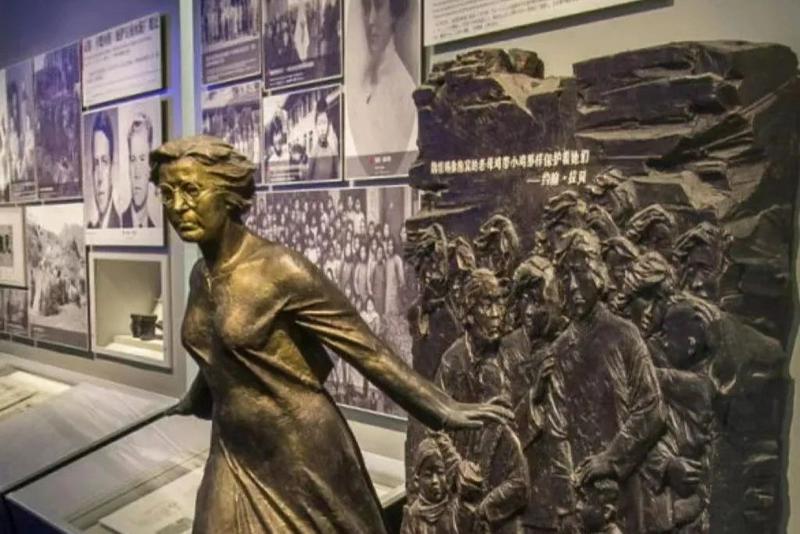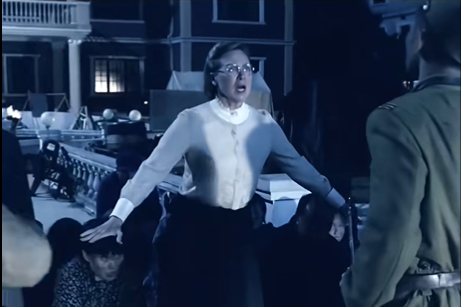The recently released Chinese movie "Dead to Rights" has drawn widespread attention for the depiction of Japanese wartime atrocities in China, prompting renewed public interest in the historical figures behind the story.
The movie is inspired by a photo album, officially designated as "Evidence No. 1," which documents the crimes committed by the Imperial Japanese Army and has become a crucial piece of evidence in the historical record of the 1937 Nanjing Massacre, which killed more than 300,000 people in more than a month.
Among the characters portrayed in the film are two foreigners who played pivotal roles during the Nanjing Massacre: American missionary Minnie Vautrin, the model for a female doctor who protects wounded Chinese civilians in the movie, and John G. Magee, a missionary who appears briefly as a photographer in the story. The Chinese people have once again commemorated their actions during one of the darkest chapters in modern history.
Minnie Vautrin: "The Living Goddess of Mercy"
Minnie Vautrin was born in Secor, Illinois, in 1886 and graduated from the University of Illinois in 1912. That same year, she was sent to China by the United Christian Missionary Society. She initially served as principal of the San Yu Girls School in Lu Zhou, Anhui Province (modern-day Hefei), and later joined the faculty at Ginling Women's University in Nanjing in 1919, where she served until 1940, twice acting as dean of the College of Arts and Sciences.
When Japanese forces began bombing Nanjing in August 1937, Vautrin chose to stay behind and helped establish the Nanking Safety Zone alongside about two dozen other foreigners. The zone offered protection to hundreds of thousands of civilians. As the director of the Ginling College Refugee Camp, which housed primarily women and children, Vautrin sheltered over 10,000 people at its peak. She often physically stood between Japanese soldiers and the refugees, earning her the nickname "Goddess of Mercy" from those she protected. John Rabe, the German businessman and head of the Safety Zone, likened her to "a hen protecting her chicks."
Vautrin kept detailed daily journals of what she witnessed—records that remain among the most valuable firsthand accounts of the massacre. Tragically, the trauma took a lasting toll on her. After returning to the United States in May 1940, she suffered from severe depression and took her own life in May 1941. She is buried in Shepherd, Michigan, and her gravestone bears the Chinese inscription "Jinling Eternal." In 2002, a bronze statue of her was unveiled at Nanjing Normal University, with her own words etched into the base: "I will do my utmost to let the truth be known."
John G. Magee: Documenting Atrocity With Camera
Born in 1884 in a family of lawyers in the United States, John G. Magee, graduated from Yale University and the Episcopal Divinity School in Cambridge, Massachusetts. He was ordained by the Episcopal Church in 1912 and served as a missionary in China for nearly three decades, based at the Doshan Church just outside the Yijiang Gate in Nanjing. During the Nanjing Massacre, he joined the International Committee for the Nanking Safety Zone and served as the chairman of the Nanjing branch of the International Red Cross.
Magee used a 16mm camera to capture harrowing scenes of the massacre. His four reels of footage, totaling 105 minutes, remain the only known moving images of the atrocities committed in Nanjing. These films gained international attention when shown in the United States and Japan, shocking global audiences. In 1946, Magee testified at the International Military Tribunal for the Far East (Tokyo Trials), where his footage was used as key evidence against Japanese war criminals.
During the war between America and Japan in 1941, Magee returned to the United States and continued to serve as a pastor. In 1953, Magee died in Pittsburgh. Magee had left such a will before he died: "If I am born again to serve Chinese, China will be my home."
Magee's church in Nanjing (now the library of Nanjing No. 12 Middle School) was later renamed the "John Magee Library" in 2000, in honor of his bravery and contributions to preserving the truth of history.













